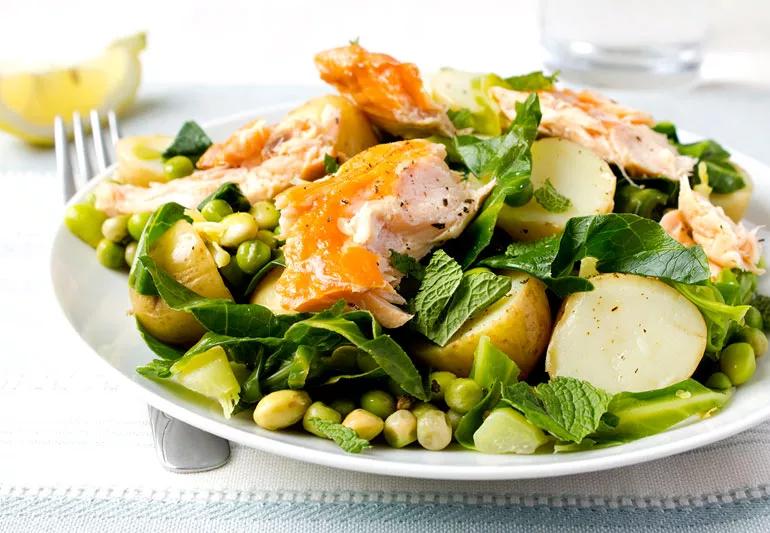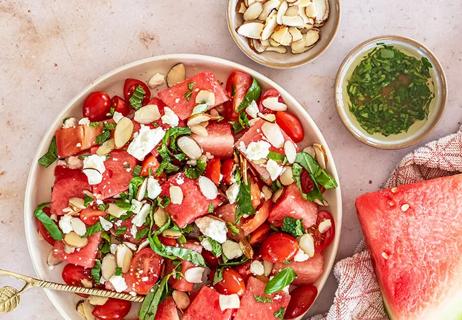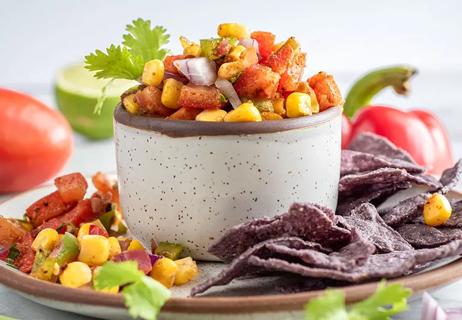You'll be a salad lover in no time with this guide to getting those daily veggies in

Want to know a simple, delicious way to get your four servings of vegetables per day? Put together a nice, big salad.
Advertisement
Cleveland Clinic is a non-profit academic medical center. Advertising on our site helps support our mission. We do not endorse non-Cleveland Clinic products or services. Policy
At least one sizable salad every day is the perfect way to get your daily servings in all at once — giving you flexibility with other meals and making sure you’re always on track with your daily nutrition requirements.
Yes, it’s that easy. Here dietitian Laura Jeffers, MEd, RD, LD, gives some tips for creating endless salad combinations with ingredients that are both nutritious and delicious — with each ingredient chock full of the healthy nutrients listed in the USDA National Nutrient Database for Standard Reference.
“My favorite salad is blackened salmon with goat or feta cheese, garbanzo beans, Greek olives, beets, tomatoes, carrots and cucumber,” Jeffers says. “I’ll eat any dark green leaf, but spinach is my favorite. I gave up my iceberg lettuce fetish years ago and my body is thanking me. If you use the guide below, you’ll get to feel the same!”
Start with local, seasonal produce from your farmer’s market or grocery store, then add protein and a healthy dressing and you’re good to go.
Follow this guide daily to optimize your metabolic health, energy and overall well-being!
Advertisement
Pro tip: Steer clear of iceberg and other pale lettuces. Their high water content means fewer nutrients.
Pro tip: Avoid croutons, tortilla strips, wonton strips and chow mein noodles. They’re high in fat and sodium, low in nutrients.
Pro tip: Add no more than 2 tablespoons of corn or peas per serving of salad. They’re high in starch just like bread.
Pro tip: Full-fat cheeses are high in saturated fat. Trying pairing small amounts of your favorite cheese with other proteins.
Pro tip: Dried cranberries, blueberries, cherries, dates and raisins are higher in sugar than fresh fruit. A little goes a long way!
Pro tip: White potatoes are high in starch, so add sliced sweet potatoes instead since they’re delicious raw and are super-crunchy like carrots.
Pro tip: Remember to factor the salt, often high in canned goods, into your daily sodium intake.
Pro tip: Use more vinegar and citrus, and less oil. Avoid high-calorie, high-fat Ranch, Thousand Island and French dressings.
Jeffers suggests if you don’t often eat salad, try starting with one or two a week. If that’s too much to start with, try experimenting with hearty bowls of grains, beans, egg, chicken or tuna, then add as many of the veggies mentioned above as you can.
Advertisement
Even fruit salads can at least help you get your 2 to 3 daily servings of fruit.
“After you wrap salads into your diet regularly you’ll be surprised at how you’ll begin to feel good about what you’re eating — and how creative you can get. Then, slowly build up to one each day, plus full-meal salads once or twice a week. You’ll soon have more energy and feel better than ever.”
Final tip: If you really don’t love salad, veggies in any form are fine — just make sure you get those 4 servings in any way you can!
Advertisement
Learn more about our editorial process.
Advertisement

Crunchy, hearty and sweet

Fresh tomato goodness with homemade olive oil and vinegar dressing

Fresh mint makes this veggie-packed salad aromatic and delicious

A great summer salad, perfect for picnics and cookouts

What better time than summertime to try this simple corn salad!

If you’re feeling short of breath, sleep can be tough — propping yourself up or sleeping on your side may help

If you fear the unknown or find yourself needing reassurance often, you may identify with this attachment style

If you’re looking to boost your gut health, it’s better to get fiber from whole foods